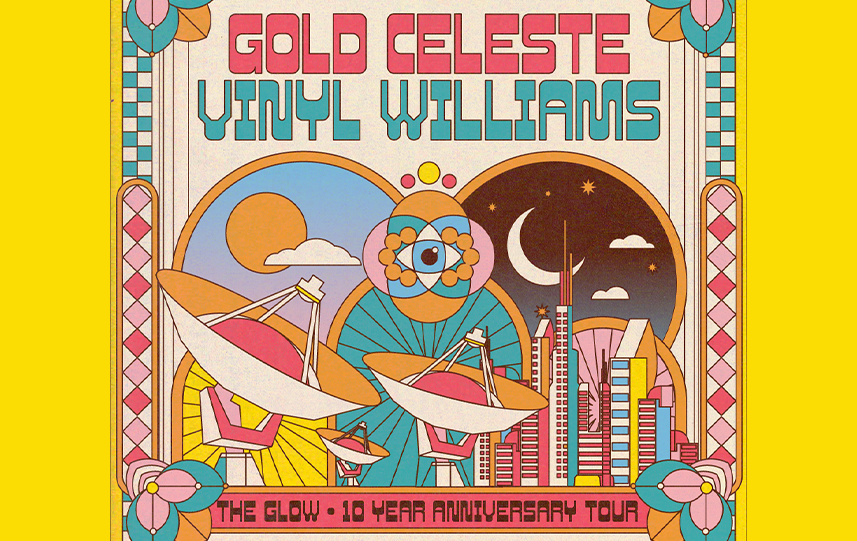

Gold Celeste
Gold Celeste is steeped in inspiration, drawing from the relentless energy of the ’60s, the sweet soul of the ’70s, the contrarians of ’80s indie and hip-hop, and the lo-fi, shoegaze, and dream pop of the ’90s. Their sound places them alongside modern peers like Dungen, Tame Impala, and Deerhunter, riding the same wave of kaleidoscopic exploration.
The band met in Trondheim around 2010 while studying music and recorded their debut album between 2012 and 2015. Their studio, run by singer and bass player Simen, became the creative hub where The Glow took shape. Shortly after its release in 2015, Eirik, Petter, and Simen relocated to Oslo, where they immersed themselves in a damp, cluttered rehearsal space-turned-makeshift studio.
There, they recorded hours of music, embraced the analog process of live jamming, and laid down trio song skeletons while continuously expanding their musical toolbox. Around this time, they also welcomed Torstein Holum, Peter Hiley and Eirik Kirkemyr into the live lineup. Gold Celeste continued refining their arrangements, and their 2018 follow-up record, The Gentle Maverick, was a spirited and ambitious voyage. On May 1st, 2020, they released the single Eye of the Storm, followed by the four-track EP Common Ground on May 22nd.
Since 2020, the band has been crafting new material, playing occasional concerts, and steadily building creative and physical energy. As they celebrate the 10-year anniversary of The Glow, they see it as both a chance to shake off “demo-itis” and an opportunity to reconnect with longtime fans while reaching new listeners.
Vinyl Williams
Almost two decades into his career, Lionel (Vinyl) Williams is an enduring fixture of the psychedelic scene. He unveiled his Vinyl Williams alias in 2007, immediately establishing the blueprint for a sound that shimmers like bioluminescent glitter. With releases on labels including Chaz Bear’s Company Records, Requiem Pour Un Twister, and Harmony Records, Williams translates vast, galactic concepts into cosmic sonic textures. It seems fitting that Williams is the inventor of a system for understanding relationships called Musical Astrology — an app that allows you to hear the music of your birthdays, as well as the precise musical pitches of the planets in relation to Earth, on any given day.
Williams grew up in a musical family, and spent his childhood orbiting recording studios. He initially wanted to push against the grain and avoid the family business to become a roller coaster engineer, physicist, or architect. But he stopped being able to deny his calling after picking up the drums at 10 years old. As a teenager living in Utah a few years later, Williams formed his first band. His career inadvertently snowballed from there, and Williams found himself a burgeoning force in a bohemian corner of the indie rock landscape.
Upon relocating to Los Angeles in the mid 2000s, Vinyl Williams ascended in tandem with the blossoming California underground. He cut his teeth circling influential DIY spaces like Non Plus Ultra — where he also lived at one point — and honed his process across the 3rd & 4th LPs with Brunei and Opal. Williams fondly reflects on that period as being filled with music “all the time, every day.” As similarly sun soaked bands dominated the critical conversation, Williams began to share stages with kindred spirits including Toro y Moi, Unknown Mortal Orchestra, Mount Kimbie, and others.
A formally trained visual artist who studied at California Institute of the Arts, Williams’ identities seem to feed off similar senses of imagination and headiness. He has crafted music videos and 3D interactive worlds for Unknown Mortal Orchestra and Tears For Fears, serving musicians he admires away from his solo pursuits. Williams is also a freelance booking agent, and embraces a regimented workflow to maintain balance. “Most of my time is spent creating pieces for other artists,” he says, reflecting on juggling practices. “I definitely have to dedicate entire days to visuals or a song.” Even still, this array of symbiotic pursuits all seem tethered to his roots with Vinyl Williams in unique ways.
Williams’ new double LP, Polyhaven / Portasymphony, emphasizes the flip sides of his sound. Polyhaven is a word that Williams uses to describe an image of a floating island in the sky. It was recorded using reel to reel and digital techniques, as an exercise in extreme high fidelity. Portasymphony is titled as a reference to recording a symphony using a Tascam Portastudio. An experiment in lo-fi limitation, its 17 tracks came to life entirely on the titular 8-track cassette machine. Held side by side, Polyhaven and Portasymphony contrast opposing qualities in intriguing ways. Across both records, Williams pulls from trippy memories such as going to The Integratron and feeling completely weightless. Packaged together as a gatefold LP with a lenticular cover, the records will live on as an eternal artifact symbolizing Williams’ seemingly endless wellspring of ideas.